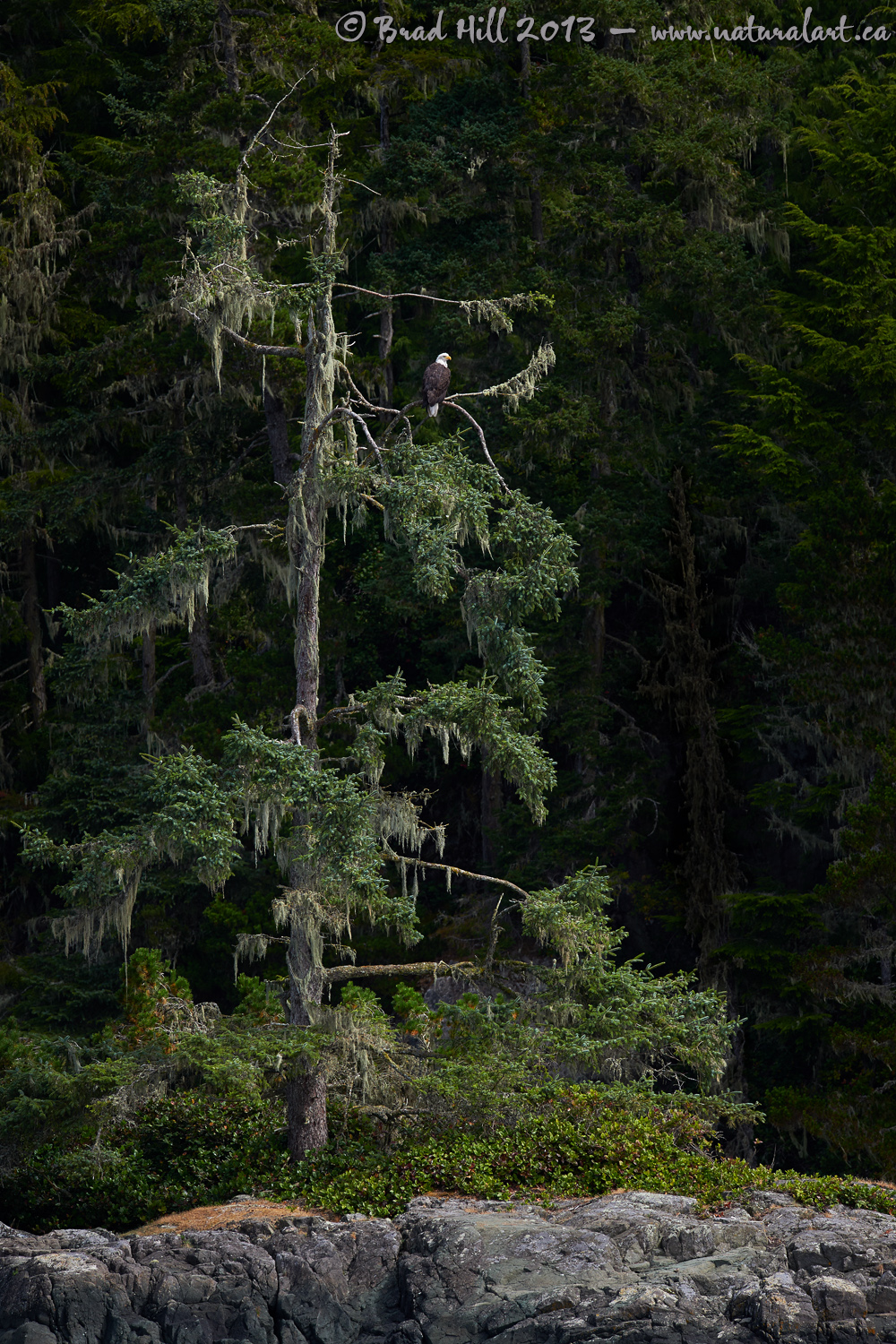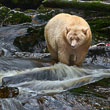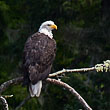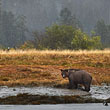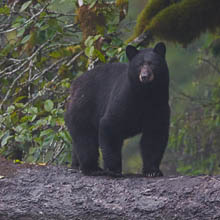Availability: Limited Edition Print - info coming soon!
In the Field
The Perch. Northern Vancouver Island, BC, Canada. August 24, 2012.
I captured this image of an adult Bald Eagle perched in a beautiful moss-laden tree along a coastal shoreline during my 2012 "Aquatic Mammals of the Central Pacific Coast" photo tour. To me it was just a wonderful animalscape* scene (and - I hope - image) that captured the "essence" of that spectacular region. Of course, the leader of the tour chastised me for photographing a "measly" eagle when on a MAMMAL photo tour, but I can live with that (I'm kidding of course - I was the leader of the tour).
There's a lot of ways to take the discussion about this image. I'm tempted to go down the "why I love my 400mm f2.8 VR lens" path, but I've done that enough times before. But another interesting "angle" on this shot pertains to a minor conflict between those bucket lists and staying open to fleeting photographic opportunities (or as I like to put it, "opportunity recognition"). As mentioned above, this scene materialized in front of us during an aquatic MAMMAL photo tour. There was a group of Steller Sea Lions on the rocks immediately below the rocks in this image but, to be honest, they were in poor light (especially relative to this eagle) and had little in the way of good supporting "material" (e.g., good background, etc.) with them. And, we had already had dramatically better photo ops of sea lions earlier in the trip. So I just ignored the sea lions and chose to work this eagle. I was the only one in the group that did. Later, when I showed the processed image to a few who were on the trip the response was "WOW - that's beautiful - where did you see that?" My response? "You ALL saw it (and I pointed it out to you), but because you were focused on the sea lions you just failed to recognize the opportunity."
There's nothing at all wrong with have bucket or "hit" lists of images you want to capture. But, if you can find a way to keep that list from closing down your ability to recognize unplanned or unexpected photo opportunities, you'll often go home from a photo trip with significantly more top-shelf images.
There's at least one other issue that this image points out. I personally love digital technology and most of what it has done to photography, including how much easier it is now to get our images "out there" and seen. BUT, given the current state of technology - and most specifically monitor resolution - it is almost impossible to fully showcase "scapes" (be they landscapes or animalscapes like this one) and do them justice online. At even 1200 pixels on the long axis (which is the size of the larger version of the image shown here), the rich detail on both the bird and the tree that makes this image work is lost. But, if you post a larger version, you do run the risk of someone absconding with the image (and potentially impacting on its economic value to you the photographer). The trend to super hi-res displays (like the "Retina Display" on several recent Apple products) does partially mitigate against the problem of making your 'scapes shine, but you still run the risk of having your image swiped by someone...
Anyway...this image needs to be seen even larger to truly shine, so here's a "medium" resolution (2400 pixel) version of the image!
• The Perch: Download 2400 pixel image (JPEG: 1.9 MB)
ADDITIONAL NOTES:
1. This image - in all resolutions - is protected by copyright. I'm fine with personal uses of it (including use as desktop backgrounds or screensavers on your own computer), but unauthorized commercial use of the image is prohibited by law. Thanks in advance for respecting my copyright!
2. Like all wildlife photographs on this website, this image was captured following the strict ethical guidelines described in The Wildlife FIRST! Principles of Photographer Conduct. I encourage all wildlife photographers to always put the welfare of their subjects above the value of their photographs.
3. This image was captured during my "Humpback, Orcas, Sea Lions & More" photo tour in August of 2010. Each year I offer trips into two different parts of the Great Bear Rainforest as well as one to photograph aquatic mammals and oceanscapes near the northern tip of Vancouver Island. And, in selected years, I also offer photo tours to locations to capture other highly sought-after subjects, such as various owl species of the boreal forest and wildlife of Canada's Arctic. Details about these trips can be found on the Photo Tours page of this website.
*4. For a more detailed discussion of the image types I call animalscapes and enviroscapes (and the subtle distinctions between them), just go here...
Behind the Camera
The Perch. Northern Vancouver Island, BC, Canada. August 24, 2012.
Digital Capture; Compressed RAW (NEF) 14-bit format; ISO 220.
Nikon D4 paired with Nikkor 400mm f2.8 VRII prime lens; hand-held from sailboat. VR on and in normal mode.
1/400s @ f6.3; -0.67 stop compensation from matrix-metered exposure setting. Auto ISO engaged with shutter speed set to "Auto" (1/focal length of lens).
At the Computer
The Perch. Northern Vancouver Island, BC, Canada. August 24, 2012.
RAW Conversion to 16-bit TIFF, including first-pass/capture sharpening and light noise reduction using Capture One Pro version 6. Three raw variants (processed from raw) differing by a total of 0.9 stops in exposure.
Further digital corrections on resulting 16-bit TIFF files using Adobe's Photoshop CS6 and Light Craft's Lightzone. Photoshop adjustments included compositing the raw conversion exposure variants, selective minor tweaks to exposure, selective colour saturation and desaturation, and selective sharpening for web output. Final tone tweaking performed using tonemapper/re-light tool in Lightzone.
Conservation
The Perch. Northern Vancouver Island, BC, Canada. August 24, 2012.
Ten percent of the revenue generated by this image will be donated to Raincoast.
Species Status in Canada*: This species is not designated as at risk. The Bald Eagle was listed as "Endangered" in the contiguous US states from 1967 to 1995. In 1995 it was downlisted to "Threatened". On June 28, 2007 Bald Eagles were removed from the list of endangered and threatened species - a true American conservation success story.
The Bald Eagle (Haliaeetus leucocephalus) is a very large bird of prey with broad wings. Adults possess characteristic white ("bald") heads. It takes Bald Eagles a full five years to attain their characteristic adult plumage (including their nearly pure white head and tail). In the years prior to the development of their adult plumage they are easy to confuse with Golden Eagles. Being very broad-winged Bald Eagles are able to use an energy-efficient flapping-soaring style of flight. While many people like to think of the Bald Eagle as a fierce hunter, in reality they hunt only as a last resort. More commonly they scavenge for their prey. Additionally, they often klepto-parasitize other weaker species such as Osprey, commonly stealing the other species hard-earned prey items. The Bald Eagle is, of course, the national emblem of the United States (Benjamin Franklin argued against this - his preference was for the Wild Turkey).
This Bald Eagle was photographed along the beautiful BC coast. While Bald Eagles are currently not under the threat of extinction, they do, of course, require suitable breeding habitat to continue to thrive. The Raincoast Conservation Society (and Foundation) is an effective and efficient organization that has been fighting for protection of this unique habitat. If you are looking for a meaningful way to contribute to the conservation of this amazing ecosystem, Raincoast will provide maximal "bang" for your conservation dollars.
*as determined by COSEWIC: The Committee on the Status of Endangered Wildlife in Canada













